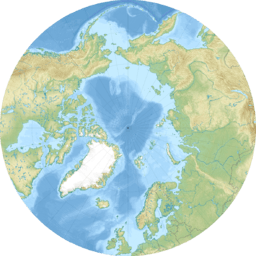83-42
83-42 is a rocky islet in the Arctic Ocean, which may be the northernmost permanent point of land on Earth. It is also sometimes referred to as Eklipse 0,[1] or Schmitt’s Island, after its discoverer, Dennis Schmitt.[2][3] It measures 35 by 15 metres (115 by 49 ft) and 4 metres (13 ft) in height, and lies 699.8 kilometres (434.8 mi) from the North Pole.[4] When it was discovered in 1998, lichens were found growing on it, suggesting it was not one of the temporary gravel bars commonly found in that region.

The island was discovered on 6 July 2003 by an American expedition, which was led by Dennis Schmitt and Frank Landsberger. Based on the latitude, the expedition members who discovered the body gave it the unofficial name 83-42. To be recognized as land area it is required that the area permanently rise out of the water, even at high tide. Given its very small size, it is doubtful whether 83-42 has this property. According to its discoverer 83-42 is composed of rocks and boulders, a relatively resistant material, and is not just a fleeting sand and gravel bank. The height of about four metres (13 feet) above the water surface could indicate that 83-42 is a permanent island given the weak tidal effect in the Arctic Ocean. As of November 2007, however, the island was not recognized as land area.
In most geography books Kaffeklubben Island is still listed as the northernmost land point. If 83-42 is granted the status of land area, it will be the northernmost land area on Earth. Since the classification of a land area as an island is not dependent on the size of the land area, 83-42 would be, if recognized as a land area, also the most northerly island in the world. Other islands which have been proposed as the northernmost include ATOW1996, RTOW2001, and Oodaaq. However, these are not thought to be permanent islands, but are semi-permanent gravel banks, moved around by waves and ice floes.
References
- "relief map". jeffshea.org. Retrieved February 19, 2018.
- Charles Burress (June 17, 2004). "Romancing the North". San Francisco Chronicle. Retrieved September 23, 2011.
- Richard Fisher (April 25, 2007). "A new Arctic island is born into our warming world". New Scientist. Retrieved September 23, 2011.
- "10 Unique And Amazing Places on Earth". Listverse. 18 December 2009. Retrieved 1 June 2017.